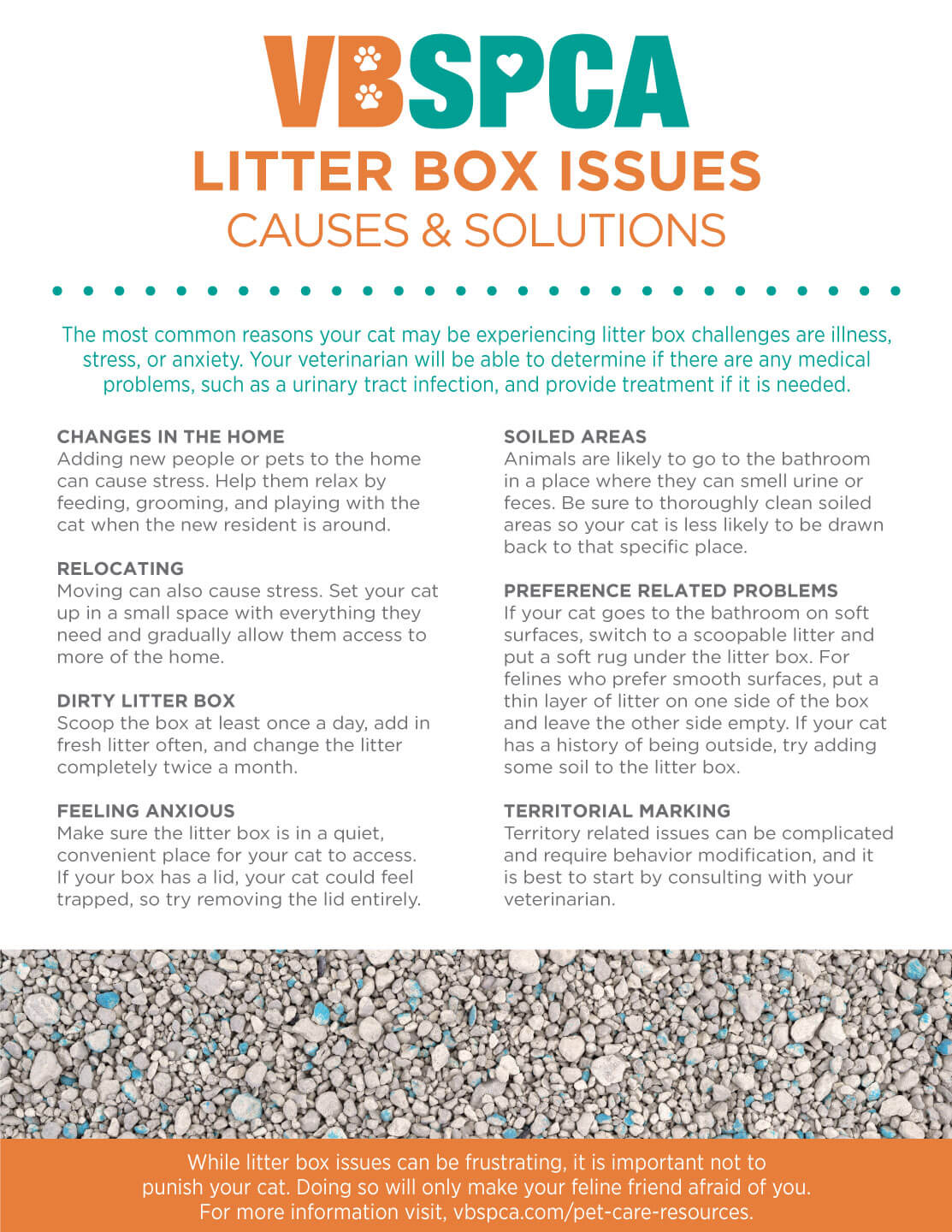While cats can be incredible companions, sometimes our feline friends to develop litter box issues. According to the ASPCA, 10% of all cats will experience elimination issues at one point or another, and staying on top of their health and mental wellness can help prevent these issues from occurring. However, even the most responsible pet parents can find themselves confronting this unpleasant issue.
The most common reasons your cat may be experiencing litter box challenges are illness, stress, or anxiety. Your veterinarian will be able to determine if there are any medical problems, such as a urinary tract infection, and provide treatment if it is needed. If your veterinarian finds that your cat does not have any medical concerns, you will need to think through your cat’s behaviors and environment to figure out what is causing your cat to make litter box mistakes.
Anxiety
Felines who are anxious or stressed may start to make litter box mistakes. Changes in the environment can lead to anxiety or stress, such as a new person in the home (like a newborn baby, roommate, or spouse), adding another pet to the family, or moving.
If your cat is reacting to a new person, help them make friends by feeding, grooming, and playing with the cat when the new resident is around. If you believe the litter box issues are related to a recent move, consider setting your cat up in a small space with everything they need and gradually allowing them access to more of the home.
Litter Box Aversion
When cats have an unpleasant litter box experience, they may choose to do their business somewhere else. Litter box aversions can quickly form when a box is not kept clean, if the cat is startled while in the box, or if a medical issue is causing the cat to experience pain while using the box.
Start by making sure your cat’s litter box is clean. Scoop it at least once a day, add in fresh litter often, and change the litter completely at least once or twice a month. You should also make sure the litter box is in a quiet place that is convenient for your cat to access. If your box has a lid, there is a chance your cat feels trapped, so try removing the lid entirely. If the problem persists, consider adding a new box in a different location and using another litter so that your cat does not associate the negative experience with the new box.
Soiled Areas
Animals are very likely to go to the bathroom in a place where they can smell urine or feces. Be sure to thoroughly clean soiled areas so your cat is less likely to be drawn back to that specific place.
Preference Related Problems
Cats may have texture or location preferences, and these preferences may be established early on or can develop later in life. If your cat avoids the litter box and habitually goes to the bathroom on soft surfaces, switch to a high quality, scoopable litter and put a soft rug under the litter box. For felines who prefer slick, smooth surfaces, try putting a thin layer of litter on one side of the box and leave the other side empty, then place the box on a hard surface. If your cat has a history of being outside, try adding some soil to the litter box.
If you have noticed that your cat avoids the litter box and always goes to the bathroom in the same place, try putting the litter box in that place and gradually moving it to a more convenient location. Another alternative is to deter your cat from using the bathroom in that location by placing an upside down carpet runner, aluminum foil, or citrus-scented cotton balls in that area.
Territorial Marking
Cats who feel threatened may mark their territory. Causes of territorial marking include conflicts between pets in the home or the presence of unfamiliar people or animals. Territory related issues can be complicated and require behavior modification, and it is best to start by consulting with your veterinarian.
While litter box issues can be frustrating, it is important not to punish your cat. Doing so will only make your feline friend afraid of using the bathroom while you are around. With a little detective work and patience, you will be able to find a solution to your cat’s litter box issues.





Last Updated: June 3, 2022 by vbspcaadmin
Litter Box Issues | Causes and Solutions
While cats can be incredible companions, sometimes our feline friends to develop litter box issues. According to the ASPCA, 10% of all cats will experience elimination issues at one point or another, and staying on top of their health and mental wellness can help prevent these issues from occurring. However, even the most responsible pet parents can find themselves confronting this unpleasant issue.

The most common reasons your cat may be experiencing litter box challenges are illness, stress, or anxiety. Your veterinarian will be able to determine if there are any medical problems, such as a urinary tract infection, and provide treatment if it is needed. If your veterinarian finds that your cat does not have any medical concerns, you will need to think through your cat’s behaviors and environment to figure out what is causing your cat to make litter box mistakes.
Anxiety
Felines who are anxious or stressed may start to make litter box mistakes. Changes in the environment can lead to anxiety or stress, such as a new person in the home (like a newborn baby, roommate, or spouse), adding another pet to the family, or moving.
If your cat is reacting to a new person, help them make friends by feeding, grooming, and playing with the cat when the new resident is around. If you believe the litter box issues are related to a recent move, consider setting your cat up in a small space with everything they need and gradually allowing them access to more of the home.
Litter Box Aversion
When cats have an unpleasant litter box experience, they may choose to do their business somewhere else. Litter box aversions can quickly form when a box is not kept clean, if the cat is startled while in the box, or if a medical issue is causing the cat to experience pain while using the box.
Start by making sure your cat’s litter box is clean. Scoop it at least once a day, add in fresh litter often, and change the litter completely at least once or twice a month. You should also make sure the litter box is in a quiet place that is convenient for your cat to access. If your box has a lid, there is a chance your cat feels trapped, so try removing the lid entirely. If the problem persists, consider adding a new box in a different location and using another litter so that your cat does not associate the negative experience with the new box.
Soiled Areas
Animals are very likely to go to the bathroom in a place where they can smell urine or feces. Be sure to thoroughly clean soiled areas so your cat is less likely to be drawn back to that specific place.
Preference Related Problems
Cats may have texture or location preferences, and these preferences may be established early on or can develop later in life. If your cat avoids the litter box and habitually goes to the bathroom on soft surfaces, switch to a high quality, scoopable litter and put a soft rug under the litter box. For felines who prefer slick, smooth surfaces, try putting a thin layer of litter on one side of the box and leave the other side empty, then place the box on a hard surface. If your cat has a history of being outside, try adding some soil to the litter box.
If you have noticed that your cat avoids the litter box and always goes to the bathroom in the same place, try putting the litter box in that place and gradually moving it to a more convenient location. Another alternative is to deter your cat from using the bathroom in that location by placing an upside down carpet runner, aluminum foil, or citrus-scented cotton balls in that area.
Territorial Marking
Cats who feel threatened may mark their territory. Causes of territorial marking include conflicts between pets in the home or the presence of unfamiliar people or animals. Territory related issues can be complicated and require behavior modification, and it is best to start by consulting with your veterinarian.
While litter box issues can be frustrating, it is important not to punish your cat. Doing so will only make your feline friend afraid of using the bathroom while you are around. With a little detective work and patience, you will be able to find a solution to your cat’s litter box issues.
Category: VBSPCA News
Search
Ways to Give
Annual Sponsors
To view our Donor Privacy Policy, click here.